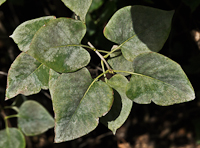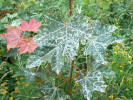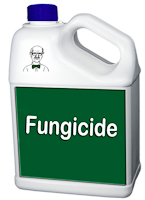|
 |
|
 |
|
 |
|
 |
 |
 Powdery mildew is one of those strange
fungal molds that grows on the surface of the leaf but
does not penetrate into the leaf tissue. It causes
damage by blocking the light from the leaf. There are
many different forms of the powdery mildew fungus and
there is a specific one for each species of plant that
it infects. See the list below for several ornamental
plants that are commonly attacked by powdery mildew. Powdery mildew is one of those strange
fungal molds that grows on the surface of the leaf but
does not penetrate into the leaf tissue. It causes
damage by blocking the light from the leaf. There are
many different forms of the powdery mildew fungus and
there is a specific one for each species of plant that
it infects. See the list below for several ornamental
plants that are commonly attacked by powdery mildew.
|
 |
|
 |
 |
 In later summer during the hottest,
most humid weather, whitish or gray coloration appears
on the leaves of many plants. It looks as if someone
took ashes from their fireplace and scattered them over
their plants. If the stuff gets thick enough, it blocks
the light from getting to the leaf surface and causes
them to lose
chlorophyll and become yellow. Late in
autumn, peppery looking black spots may appear on the
infected leaves. In later summer during the hottest,
most humid weather, whitish or gray coloration appears
on the leaves of many plants. It looks as if someone
took ashes from their fireplace and scattered them over
their plants. If the stuff gets thick enough, it blocks
the light from getting to the leaf surface and causes
them to lose
chlorophyll and become yellow. Late in
autumn, peppery looking black spots may appear on the
infected leaves.
|
 |
 |
 |
1. Resistance -
Probably the best approach to any disease, including
powdery mildew, is to avoid it. Of the plants that
are susceptible to this disease, plant breeders have
been busy trying to find types that are less prone
to the problem. Whenever possible, plant cultivars
that are known to be resistant to powdery mildew.
2. Proper Placement -
Since powdery mildew is encouraged by humid air,
susceptible plants should be placed in locations
that get plenty of sunlight and air movement. Avoid
planting them in low lying areas where heavy, humid
air will settle in around them.
3. Irrigation -
Avoid watering onto the foliage of susceptible
plants especially in the evening when the leaves do
not have time to dry out before nightfall.
|
 |
 |
 |
 There are several
fungicides labeled
for use against powdery mildew. Of course, these are
preventatives and need to be applied before infection.
This is often difficult to attain in the home garden. There are several
fungicides labeled
for use against powdery mildew. Of course, these are
preventatives and need to be applied before infection.
This is often difficult to attain in the home garden.
Other approaches include
choosing mildew resistant cultivars or species of
commonly grown ornamental plants such as garden
phlox or
lilac shrubs. Placing the plants so that they get plenty
of sun and air movement may help reduce the incidence of
powdery mildew.
|
|
 |
|
Note: We
have provided some general information and
observations on this topic aimed at the home
gardener. Before you take
any serious action in your landscape, check
with your state's land grant university's
Cooperative
Extension
Service for the most current,
appropriate, localized recommendations. |
|
 |
 |
 |
Listed below are many
ornamental plants that are liable to be infested by
powdery mildew. The range of susceptibility can be
large, however. Some of these species will only develop
minor levels of mildew depending on the environmental
conditions. Others such as common
lilac, monarda,
zinnia, salvia,
roses, etc. are plants that are
extremely susceptible and get mildew just about every
year.
|
|
|
 |
|



